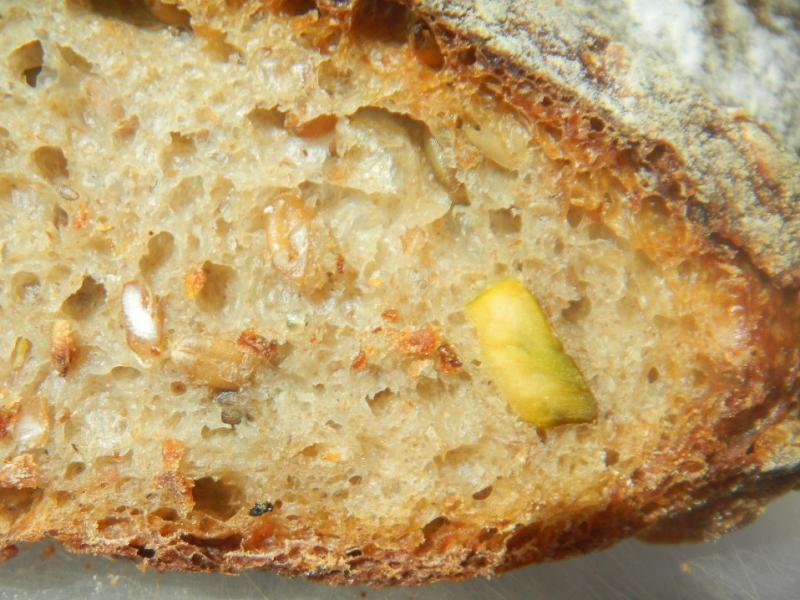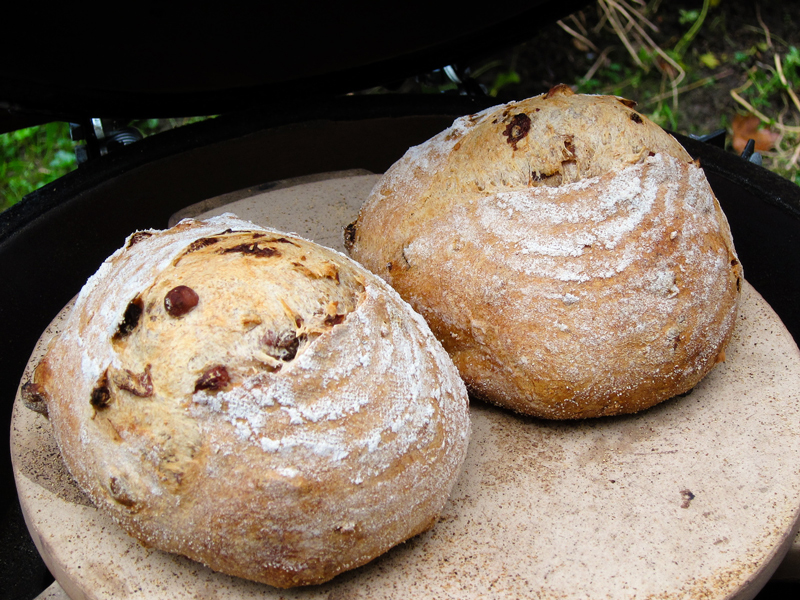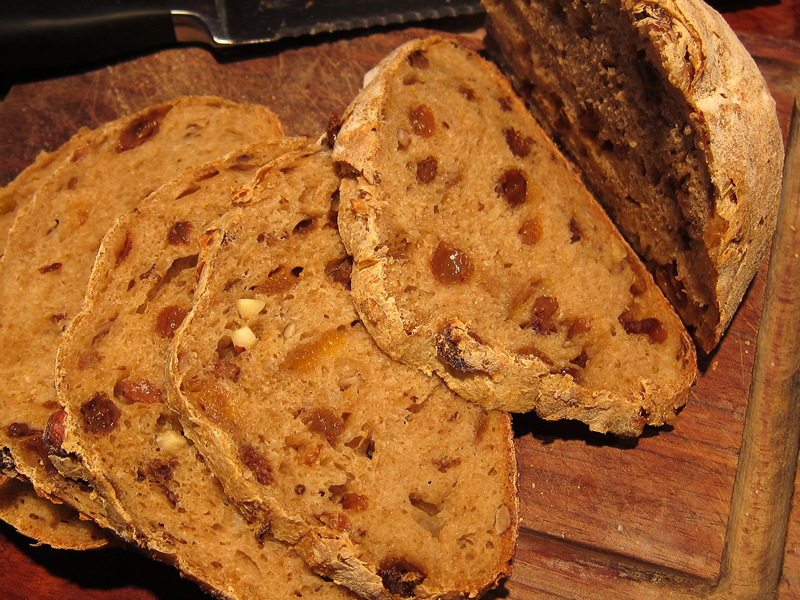No, No, No - My apprentice is not a nut! This is a slightly more simple formula trying to achieve a balance between taste and holes. Taste always wins out over holes and appearance in my book. It has to taste good first before going to other wanted crumb and crust attributes.


Sadly, when throwing boiling water into the hot cast iron skillet, water splashed onto the stone where the bread had just been placed - after sliding it off the peel taking the parchment paper with it. No problem. I will just tilt the stone and let the water run off. But alas, the bread slid off onto the oven rack making a mess of some very nice bread up until that time. Found a spatula and mooshed it back on the stone as best we could but was left with a loaf that didn’t spring as well as it should and developed a strange knob hanging off the side of it.


It did taste great though and the WW, Bulgar and hemp sprouts came through and the texture of the crumb was further enhanced with the pistachio nuts and sunflower seeds. The rye is subtle and WW is pronounced. The crumb holes were OK even though they suffered the worst of the oven loading and steaming ordeal. Formula and Method follow the crumb shots.





Multi-grain SD w/ Multi Sprouts 2 Nuts and Seeds Somewhere
| | | | | |
| | | | | |
SD Starter | Build 1 | Build 2 | Build 3 | Total | % |
SD Starter | 25 | | | 25 | 5.41% |
Rye | 25 | | | 25 | 5.41% |
WW | 25 | | | 25 | 5.41% |
AP | | 50 | 25 | 75 | 16.22% |
Water | 50 | 50 | | 100 | 21.62% |
Total | 125 | 100 | 25 | 250 | 54.05% |
| | | | | |
Starter | | % | | | |
Flour | 137.5 | 29.73% | | | |
Water | 112.5 | 24.32% | | | |
Hydration | 81.82% | | | | |
Levain % of Total | 0 | 25.08% | | | |
| | | | | |
Dough Flour | | % | | | |
Rye | 25 | 5.41% | | | |
6 Grain Cereal | 25 | 5.41% | | | |
Dark Rye | 25 | 5.41% | | | |
White WW | 50 | 10.81% | | | |
Bread Flour | 100 | 21.62% | | | |
AP | 100 | 21.62% | | | |
Dough Flour | 325 | 70.27% | | | |
Salt | 7 | 1.51% | | | |
Water | 260 | 56.22% | | | |
Dough Hydration | 80.00% | | | | |
| | | | | |
Multi-grain Sprouts | | % | | | |
Hemp | 25 | 5.41% | | | |
WW | 25 | 5.41% | | | |
Bulgar | 25 | 5.41% | | | |
Total Sprouts | 75 | 16.22% | | | |
| | | | | |
Add - Ins | | % | | | |
Honey | 10 | 2.16% | | | |
White Distatic Malt | 10 | 2.16% | | | |
VW Gluten | 10 | 2.16% | | | |
Pistachio/Sunflower | 50 | 10.81% | | | |
Total | 80 | 17.30% | | | |
| | | | | |
Hydration w/ Adds | 78.24% | | | | |
Total Weight | 997 | | | | |
Method
Do the sprouts first by soaking them for 5 hours and then letting them rest on (2) damp paper towels, covered with another and plastic wrap and reserve until needed..
The method is similar to recent bakes. A 3 stage SD levain build only this time the stages were 3 hours apart. With the AZ kitchen temps hitting90 Fa 9 hour build was more than sufficient to get a strong levain. Instead of rye based like last time, this one was more WW and AP flour based to fit the bread we were after for this bake. The dough was more AP Bread flour and White WW than usual to go with the levain.
We added some honey as it pairs so well with WWW. Had some Hemp, WW and bulgur sprouting but WW was all that sprouted so the other 2 were a soaker.
Autolyse the flours, the VWG and the diastatic malt, all the water, less 10 g, 24 hours in the fridge and retarded the levain for 12 hours, all in hopes of bringing out the sour. The next morning we kneaded the autolyse and levain with the added 10 g of water by hand before kneading on KA 2 for 8 minutes with the dough hook. Added the salt and knead for 2 more minutes on KA 3.
Transferred the dough to a well oiled bowl since this is a high hydration dough and let rest for 20 minutes. Do 4 S &F’s on a floured work surface, at 20 minute intervals- about 4-6 turns each depending on how the dough feels. When it tightened up it was time to stop. On the 5 th S& F fattened out the dough and incorporated the sprouts and nuts. Do 1 more S&F for a total of 6.
Let rest on the counter for 1 hour. You may need longer if your kitchen isn’t 90 F. Then refrigerate for 24 hours. Take the dough out of the fridge and let it warm up for an hour. Pre-shape by dragging the boule’s skin tight and then let rest for 10 minutes. Shape and place in your favorite boule final proofing container - mine is a cloth lined basket that is well floured with rice flour and AP mixed 50-50. But, you can make what ever shape suits your fancy.
Let bread rise in a plastic bag until it passes the poke test - mine took 2 hours at 86-88 F. Get oven ready at 500 F with steam and stone 45 minutes before bread is ready to bake. Turn out of the basket onto parchment and peel, slash your favorite way and place on the stone with steam for 15 minutes turning temperature down to 450 after 5 minutes. Remove steam and turn oven to 425 F convection and bake until the bread is 205 F in the middle. Turn off oven and leave bread on the stone for 12 more minutes with oven door ajar to dry out.
Move to a wire cooling rack to completely cool before cutting.







